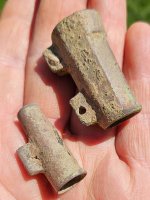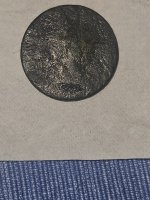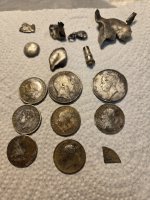Satori
Full Member
Article published Aug 2, 2009
More treasures of Tse-whit-zen uncovered on Port Angeles waterfront
By Tom Callis
and Paul Gottlieb
EDITOR'S NOTE -- This is the first article in a two-part series. The second article will appear Monday.
PORT ANGELES -- Five years after the promise of industrial development was abandoned because of the discovery of an ancient Klallam village, the site of Tse-whit-zen continues to speak across centuries.
Dozens of artifacts and a handful of bone fragments have been found daily over the last month at this 18-acre site on the industrial waterfront -- once tapped to be a graving yard to make floating bridge components.
Despite being churned by bulldozers, piled against utility pipes and cast aside like so much flotsam more than a century ago, the discoveries continue to the tell the story of the people who lived in what is now Port Angeles before being displaced, and of the culture that thrived on the shore of the harbor for more than 2,700 years.
Lower Elwha Klallam tribal members returned to the site early July to sieve through the remaining hills of disturbed soil left on the property before blanketing it back on its original resting place, free of its treasure.
Roughly 1,000 artifacts and up to 50 bones and bone fragments known as isolates have been unearthed since July 7, when tribal workers piloting a giant mechanical sifter began separating soil from history as though wheat from chaff.
Mechanical sifter
The sifter rapidly separates the artifacts and bone isolates from soil that had been excavated for the graving yard while a bulldozer buckets dirt cleaned of artifacts, isolates and bones to another pile before it's spread back on the site.
The tribe must finish sifting through the remaining piles of soil before it can build its own museum center at the site to display the artifacts that were unearthed from 2003 to 2004 when the state Department of Transportation was constructing the graving yard.
Museum plans have yet to be developed, but the tribe is aiming for construction to begin around 2012, said Lower Elwha Klallam Chairwoman Frances Charles.
The recent discoveries will be added to the trove of 64,793 artifacts previously found at the site, which are stored at Seattle's Burke Museum of Natural History, said tribal archeologist Bill White.
Transportation selected the site in 2002 as the graving yard that would build replacement components for the eastern half of the Hood Canal Bridge, which reopened June 3 after the majority of the work was done.
Work on the graving yard began in August 2003, and was halted in December 2004 due to the tens of thousands of artifacts and hundreds of burials found.
The graving yard was relocated to Tacoma but not before about $100 million was lost.
As a result of a legal settlement, the tribe received $2.5 million to build a cultural center or museum on the site, as well as 13 acres of the original 22.5-acre property. An additional 5 acres of the former graving yard is leased by the tribe from Transportation.
Premiere archaeological site
The area, considered prime waterfront real estate -- and the former site of mills and a log yard -- is today easily one of the top two archaeological sites in the United States in terms of complete burials unearthed -- 335 -- and artifacts, said tribal archeologist Bill White.
"There are only two sites that I could think of the same scale," he said, referring to Anazazahi in New Mexico and Indian Mounds in Ohio.
Of all the artifacts found by the sifter, about half are etched stones, which have only been found elsewhere in Alaska's Aleutian Islands.
Sometimes referred to as medicine stones, the stones tell stories through their intricate patterns and faded ochre, with no one stone the same as its kin, Charles said.
"It's like a book," she said, standing near picnic tables where two tribal members delicately catalogued each find and placed them in marked zip-lock bags.
The bags also contain the other recent finds at the site, whether they be stone wedges for shaping cedar, doughnut-shaped anchors made of rock, or carvings and harpoon points made of whale bone.
An archaeologist for 25 years, White notes in particular a tiny whale carved from whale bone, possibly a toy, discovered last month.
"That bone was something else," he said.
"You just never see this.
"It's typical to find arrow points, but in terms of actual carving, you just don't see that."
At the rate the tribe is working, White said the remaining piles of dirt -- about 12,000 cubic yards -- will be sifted through by October.
That amount of material left is about half of what the tribe began with. Tribal members already went through the first 12,000 cubic yards -- most being broken concrete and brick -- by hand.
Their efforts produced only about 75 artifacts.
Without the sifter, which goes through about 180 cubic yards a day, the process would take another 10 to 20 years, Charles said.
It does the work much more quickly than by hand.
That's a good thing, Charles said, but there is a painful downside.
She and other tribal members fear it won't retrieve every artifact for display or bone or isolate for reburial.
"I'm concerned about it," she said.
"We know we are missing something, and the machine can't slow down any slower than it is."
But Charles said the eight tribal members working at the site are happy to be able to continue the search for artifacts removed from the ground.
"We are always concerned about it sitting too long," she said, referring to the site.
"It brings back the memories. It brings back the hurt. But they like the beauty that they see and witness."
More treasures of Tse-whit-zen uncovered on Port Angeles waterfront
By Tom Callis
and Paul Gottlieb
EDITOR'S NOTE -- This is the first article in a two-part series. The second article will appear Monday.
PORT ANGELES -- Five years after the promise of industrial development was abandoned because of the discovery of an ancient Klallam village, the site of Tse-whit-zen continues to speak across centuries.
Dozens of artifacts and a handful of bone fragments have been found daily over the last month at this 18-acre site on the industrial waterfront -- once tapped to be a graving yard to make floating bridge components.
Despite being churned by bulldozers, piled against utility pipes and cast aside like so much flotsam more than a century ago, the discoveries continue to the tell the story of the people who lived in what is now Port Angeles before being displaced, and of the culture that thrived on the shore of the harbor for more than 2,700 years.
Lower Elwha Klallam tribal members returned to the site early July to sieve through the remaining hills of disturbed soil left on the property before blanketing it back on its original resting place, free of its treasure.
Roughly 1,000 artifacts and up to 50 bones and bone fragments known as isolates have been unearthed since July 7, when tribal workers piloting a giant mechanical sifter began separating soil from history as though wheat from chaff.
Mechanical sifter
The sifter rapidly separates the artifacts and bone isolates from soil that had been excavated for the graving yard while a bulldozer buckets dirt cleaned of artifacts, isolates and bones to another pile before it's spread back on the site.
The tribe must finish sifting through the remaining piles of soil before it can build its own museum center at the site to display the artifacts that were unearthed from 2003 to 2004 when the state Department of Transportation was constructing the graving yard.
Museum plans have yet to be developed, but the tribe is aiming for construction to begin around 2012, said Lower Elwha Klallam Chairwoman Frances Charles.
The recent discoveries will be added to the trove of 64,793 artifacts previously found at the site, which are stored at Seattle's Burke Museum of Natural History, said tribal archeologist Bill White.
Transportation selected the site in 2002 as the graving yard that would build replacement components for the eastern half of the Hood Canal Bridge, which reopened June 3 after the majority of the work was done.
Work on the graving yard began in August 2003, and was halted in December 2004 due to the tens of thousands of artifacts and hundreds of burials found.
The graving yard was relocated to Tacoma but not before about $100 million was lost.
As a result of a legal settlement, the tribe received $2.5 million to build a cultural center or museum on the site, as well as 13 acres of the original 22.5-acre property. An additional 5 acres of the former graving yard is leased by the tribe from Transportation.
Premiere archaeological site
The area, considered prime waterfront real estate -- and the former site of mills and a log yard -- is today easily one of the top two archaeological sites in the United States in terms of complete burials unearthed -- 335 -- and artifacts, said tribal archeologist Bill White.
"There are only two sites that I could think of the same scale," he said, referring to Anazazahi in New Mexico and Indian Mounds in Ohio.
Of all the artifacts found by the sifter, about half are etched stones, which have only been found elsewhere in Alaska's Aleutian Islands.
Sometimes referred to as medicine stones, the stones tell stories through their intricate patterns and faded ochre, with no one stone the same as its kin, Charles said.
"It's like a book," she said, standing near picnic tables where two tribal members delicately catalogued each find and placed them in marked zip-lock bags.
The bags also contain the other recent finds at the site, whether they be stone wedges for shaping cedar, doughnut-shaped anchors made of rock, or carvings and harpoon points made of whale bone.
An archaeologist for 25 years, White notes in particular a tiny whale carved from whale bone, possibly a toy, discovered last month.
"That bone was something else," he said.
"You just never see this.
"It's typical to find arrow points, but in terms of actual carving, you just don't see that."
At the rate the tribe is working, White said the remaining piles of dirt -- about 12,000 cubic yards -- will be sifted through by October.
That amount of material left is about half of what the tribe began with. Tribal members already went through the first 12,000 cubic yards -- most being broken concrete and brick -- by hand.
Their efforts produced only about 75 artifacts.
Without the sifter, which goes through about 180 cubic yards a day, the process would take another 10 to 20 years, Charles said.
It does the work much more quickly than by hand.
That's a good thing, Charles said, but there is a painful downside.
She and other tribal members fear it won't retrieve every artifact for display or bone or isolate for reburial.
"I'm concerned about it," she said.
"We know we are missing something, and the machine can't slow down any slower than it is."
But Charles said the eight tribal members working at the site are happy to be able to continue the search for artifacts removed from the ground.
"We are always concerned about it sitting too long," she said, referring to the site.
"It brings back the memories. It brings back the hurt. But they like the beauty that they see and witness."





